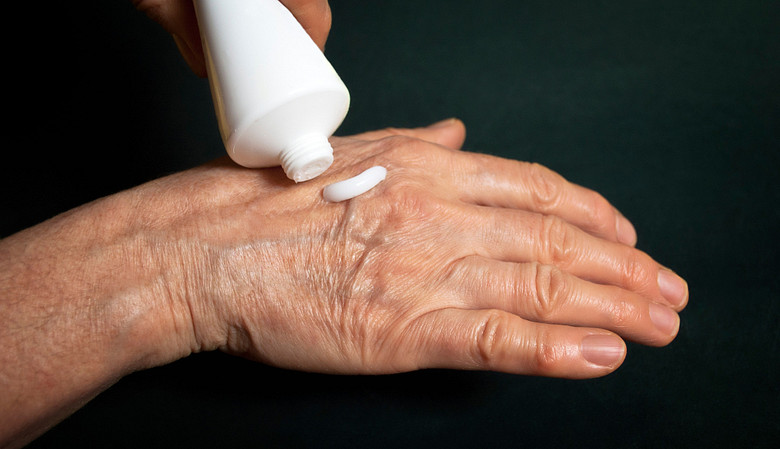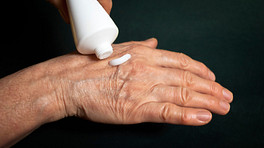If you have joint pain and want to avoid oral pain medications, a topical pain reliever may be a good option. Topical pain relievers are applied to the skin over the painful area and tend to have fewer side effects than oral medications.
Over-the-counter topical pain relievers fall into a few general categories: counterirritants, salicylates, capsaicin, and anesthetics, as well as the newer CBD topicals. How do you know which type is best for you? This guide describes each type, including how it works and potential pros and cons.
Counterirritants
Sold under brand names such as Icy Hot, Tiger Balm, BioFreeze, and Gold Bond, counterirritants work by creating temporary hot or cold sensations that distract the brain and interrupt pain signals. Examples of counterirritant active ingredients include menthol, eucalyptus, camphor, and wintergreen.
Pros: The natural ingredients in counterirritants are typically safe and may cause only minor side effects, like skin irritation.
Cons: Counterirritants can produce a strong odor.
Salicylates
Sold under brand names such as Aspercreme and Sportscreme, salicylates work by delivering a small dose of anti-inflammatory medication that’s chemically similar to aspirin. Some topical products, like Bengay or Thera-gesic, are a combination of salicylates and counterirritants.
Read more about Pain Medications for Arthritis Pain Relief
Pros: Salicylates can temporarily reduce acute pain and are odor-free.
Cons: Salicylates can cause drug interactions with medications such as blood-thinners. If you are sensitive to aspirin or take a medication that may interact with aspirin, talk with your doctor before using a salicylate.
Capsaicin
Developed from chili peppers, capsaicin creates a burning sensation. Many experts also believe that capsaicin stimulates the release of a chemical in the body called “substance P,” which is involved in pain signals in the nervous system. After releasing substance P there is less of it available, so pain signals become less frequent.
See Capsaicin Cream for Joint Pain
Capsaicin products are sold under brand names such as Capzasin and Zostrix. Capsaicin cream can also be made at home.
Pros: Capsaicin can be effective even on deeper joints below the skin, such as back, hips, and shoulders. It also has low side effect risks.
Cons: It may take a couple of weeks of daily use before experiencing results. Also, the burning sensation may be too intense for some people, so you should try it on a small area first. It needs to be applied while wearing gloves, and hands should be washed afterward. Avoid contact with your eyes and mouth.
Also, capsaicin can lose its effectiveness over time due to damage to the nerve tissues.
See Advantages and Disadvantages of Homemade Capsaicin Cream
Anesthetics
A numbing and desensitizing agent, lidocaine “mutes” pain signals. It is sold under product names such as Salonpas patches, Aspercreme with Lidocaine, and Icy hot with Lidocaine.
Pros: Lidocaine is an effective anesthetic for arthritis and musculoskeletal pain and is available in both over-the-counter and prescription strengths.
Cons: Overuse can lead to serious side effects such as irregular heartbeat, so it’s important to follow manufacturer’s instructions.
Also, lidocaine should not be used in combination with heat packs or cold compresses. The numbing action of lidocaine diminishes your sense of hot and cold, which can result in accidental burns or damaged skin.
CBD Topicals
Cannabidiol, commonly referred to as CBD, is the non-psychoactive component of marijuana and a relatively new addition to over-the-counter pain reliever products. CBD-infused creams and gels are absorbed by the skin, and limited research suggests they may reduce inflammatory and neuropathic pain. 1 Burstein S. Cannabidiol (CBD) and its analogs: a review of their effects on inflammation. Bioorg Med Chem. 2015 Apr 1;23(7):1377-85. doi: 10.1016/j.bmc.2015.01.059. Epub 2015 Feb 7. Review. PubMed PMID: 25703248. , 2 Jorge LL, Feres CC, Teles VE. Topical preparations for pain relief: efficacy and patient adherence. J Pain Res. 2010;4:11-24. Published 2010 Dec 20. , 3 Russo EB. Cannabinoids in the management of difficult to treat pain. Ther Clin Risk Manag. 2008;4(1):245–259. doi:10.2147/tcrm.s1928
Pros: CBD topicals are an alternative for people who want to avoid NSAIDs altogether or who don’t like the numbing and heat sensations of other topicals. Also, some research suggests that CBD can also help reduce anxiety and improve sleep, 4 Crippa, J. A. S., Derenusson, G. N., Ferrari, T. B., Wichert-Ana, L., Duran, F. L., Martin-Santos, R., ... & Filho, A. S. (2011). Neural basis of anxiolytic effects of cannabidiol (CBD) in generalized social anxiety disorder: a preliminary report. Journal of Psychopharmacology, 25(1), 121-130. , 5 Shannon S, Lewis N, Lee H, Hughes S. Cannabidiol in Anxiety and Sleep: A Large Case Series. Perm J. 2019;23:18–041. doi:10.7812/TPP/18-041 two problems that are often associated with chronic arthritis pain.
Cons: CBD products tend to carry a bigger price tag than other topicals. Also, depending on where you live, there may still be a stigma associated with these products even though they contain only a negligible amount of THC and do not produce a “high.”
Other Topical Products
There are a few other topical products worth mentioning that do not necessarily fit into the above categories. One is emu oil products, such as Australian Dream and Blue Emu. Emu oil products may help reduce pain and inflammation, 6 Jeengar MK, Kumar PS, Thummuri D, Shrivastava S, Guntuku L, Sistla R, Naidu VG. Review on emu products for use as complementary and alternative medicine. Nutrition. 2015 Jan;31(1):21-7. doi: 10.1016/j.nut.2014.04.004. Epub 2014 Apr 19. Review. PubMed PMID: 25441585. , 7 Chan A, De Boer R, Gan A, Willsher P, Martin R, Zissiadis Y, Miller K, Bauwens A, Hastrich D. Randomized phase II placebo-controlled study to evaluate the efficacy of topical pure emu oil for joint pain related to adjuvant aromatase inhibitor use in postmenopausal women with early breast cancer: JUST (Joints Under Study). Support Care Cancer. 2017 Dec;25(12):3785-3791. doi: 10.1007/s00520-017-3810-9. Epub 2017 Jul 9. PubMed PMID: 28691132. particularly if they also contain curcumin. 8 Jeengar MK, Shrivastava S, Nair K, Singareddy SR, Putcha UK, Talluri MV, Naidu VG, Sistla R. Improvement of bioavailability and anti-inflammatory potential of curcumin in combination with emu oil. Inflammation. 2014 Dec;37(6):2139-55. doi: 10.1007/s10753-014-9948-4. PubMed PMID: 25028100. , 9 Jeengar MK, Shrivastava S, Mouli Veeravalli SC, Naidu VG, Sistla R. Amelioration of FCA induced arthritis on topical application of curcumin in combination with emu oil. Nutrition. 2016 Sep;32(9):955-64. doi: 10.1016/j.nut.2016.02.009. Epub 2016 Mar 8. PubMed PMID: 27178879.
Another alternative is arnica-containing topical products. Arnica is an herb in the sunflower family whose flowers are used medicinally for stiffness and pain relief. 10 Iannitti T, Morales-Medina JC, Bellavite P, Rottigni V, Palmieri B. Effectiveness and Safety of Arnica montana in Post-Surgical Setting, Pain and Inflammation. Am J Ther. 2016 Jan-Feb;23(1):e184-97. doi: 10.1097/MJT.0000000000000036. Review. PubMed PMID: 25171757. , 11 Pumpa KL, Fallon KE, Bensoussan A, Papalia S. The effects of topical Arnica on performance, pain and muscle damage after intense eccentric exercise. Eur J Sport Sci. 2014;14(3):294-300. doi: 10.1080/17461391.2013.829126. Epub 2013 Aug 16. PubMed PMID: 23947690. It is sold under various names, including Topricin and Arnicare.
These products are less commonly used than the others listed above, and have limited research in humans to support them.
Prescription Topicals
In addition to these over-the-counter options, certain topical pain medications are available with a prescription, including topical NSAIDs like Voltaren (diclofenac) and prescription-strength lidocaine patches (Lidoderm).
See Prescription Topical Arthritis Pain Relief
Follow Instructions
Overall, topical pain relievers are a great option for those who experience intermittent pain in their joints because of conditions such as osteoarthritis, rheumatoid arthritis, and bursitis. Follow a manufacturer’s instructions to use them safely and effectively.
Learn more
- 1 Burstein S. Cannabidiol (CBD) and its analogs: a review of their effects on inflammation. Bioorg Med Chem. 2015 Apr 1;23(7):1377-85. doi: 10.1016/j.bmc.2015.01.059. Epub 2015 Feb 7. Review. PubMed PMID: 25703248.
- 2 Jorge LL, Feres CC, Teles VE. Topical preparations for pain relief: efficacy and patient adherence. J Pain Res. 2010;4:11-24. Published 2010 Dec 20.
- 3 Russo EB. Cannabinoids in the management of difficult to treat pain. Ther Clin Risk Manag. 2008;4(1):245–259. doi:10.2147/tcrm.s1928
- 4 Crippa, J. A. S., Derenusson, G. N., Ferrari, T. B., Wichert-Ana, L., Duran, F. L., Martin-Santos, R., ... & Filho, A. S. (2011). Neural basis of anxiolytic effects of cannabidiol (CBD) in generalized social anxiety disorder: a preliminary report. Journal of Psychopharmacology, 25(1), 121-130.
- 5 Shannon S, Lewis N, Lee H, Hughes S. Cannabidiol in Anxiety and Sleep: A Large Case Series. Perm J. 2019;23:18–041. doi:10.7812/TPP/18-041
- 6 Jeengar MK, Kumar PS, Thummuri D, Shrivastava S, Guntuku L, Sistla R, Naidu VG. Review on emu products for use as complementary and alternative medicine. Nutrition. 2015 Jan;31(1):21-7. doi: 10.1016/j.nut.2014.04.004. Epub 2014 Apr 19. Review. PubMed PMID: 25441585.
- 7 Chan A, De Boer R, Gan A, Willsher P, Martin R, Zissiadis Y, Miller K, Bauwens A, Hastrich D. Randomized phase II placebo-controlled study to evaluate the efficacy of topical pure emu oil for joint pain related to adjuvant aromatase inhibitor use in postmenopausal women with early breast cancer: JUST (Joints Under Study). Support Care Cancer. 2017 Dec;25(12):3785-3791. doi: 10.1007/s00520-017-3810-9. Epub 2017 Jul 9. PubMed PMID: 28691132.
- 8 Jeengar MK, Shrivastava S, Nair K, Singareddy SR, Putcha UK, Talluri MV, Naidu VG, Sistla R. Improvement of bioavailability and anti-inflammatory potential of curcumin in combination with emu oil. Inflammation. 2014 Dec;37(6):2139-55. doi: 10.1007/s10753-014-9948-4. PubMed PMID: 25028100.
- 9 Jeengar MK, Shrivastava S, Mouli Veeravalli SC, Naidu VG, Sistla R. Amelioration of FCA induced arthritis on topical application of curcumin in combination with emu oil. Nutrition. 2016 Sep;32(9):955-64. doi: 10.1016/j.nut.2016.02.009. Epub 2016 Mar 8. PubMed PMID: 27178879.
- 10 Iannitti T, Morales-Medina JC, Bellavite P, Rottigni V, Palmieri B. Effectiveness and Safety of Arnica montana in Post-Surgical Setting, Pain and Inflammation. Am J Ther. 2016 Jan-Feb;23(1):e184-97. doi: 10.1097/MJT.0000000000000036. Review. PubMed PMID: 25171757.
- 11 Pumpa KL, Fallon KE, Bensoussan A, Papalia S. The effects of topical Arnica on performance, pain and muscle damage after intense eccentric exercise. Eur J Sport Sci. 2014;14(3):294-300. doi: 10.1080/17461391.2013.829126. Epub 2013 Aug 16. PubMed PMID: 23947690.











